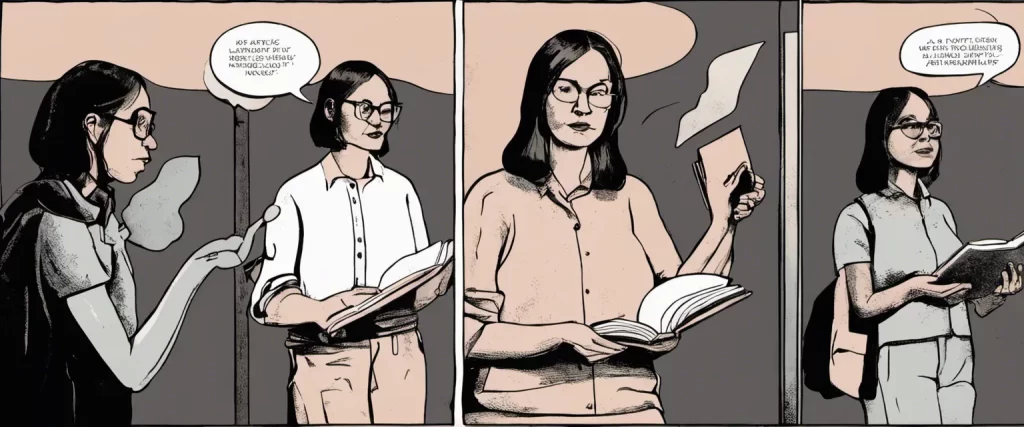——White Fragility by Robin DiAngelo & The True Believer by Eric Hoffer
In an ever-changing world, understanding the complexities of human behavior and social dynamics remains a crucial pursuit. Two notable works that have captivated readers and sparked intellectual discourse are “White Fragility” by Robin DiAngelo and “The True Believer” by Eric Hoffer. These books provide profound insights into distinct yet interconnected aspects of contemporary society, shedding light on the intricacies of prejudice, bias, and the search for meaning and identity.
At a time when discussions on race, racism, and social justice are paramount, DiAngelo’s “White Fragility” has emerged as a seminal work. DiAngelo, a sociologist and educator, delves into the construct of white fragility, a concept she defines as the defensive reactions and discomfort exhibited by white individuals when confronted with discussions about race and racism. The book serves as a call to action, urging readers to recognize and challenge their deeply ingrained prejudices, and to actively engage in critical self-reflection to dismantle systemic racism.
On the other hand, Eric Hoffer’s “The True Believer” explores the psychological and sociological foundations of mass movements and the power of belief in shaping human behaviors and societies. Originally published in 1951, Hoffer’s work remains eerily relevant, providing a timeless examination of fanaticism, extremism, and the allure of charismatic leaders. Through an exploration of historical examples, Hoffer offers profound insights into how individuals are drawn to and become devoted followers of ideologies, religions, or political movements.
While these two books may seemingly differ in their focus, they share an inherent connection through their exploration of human behavior, belief systems, and social hierarchies. Both authors raise thought-provoking questions about the nature of prejudice, identity formation, and the fragile dynamics of power. By analyzing these works side by side, we aim to explore the overlapping themes and unique perspectives presented by DiAngelo and Hoffer, ultimately considering how their ideas can inform and enrich our understanding of the world we live in today.
Throughout this comparative study, we will critically examine the authors’ arguments, methodologies, and the impact of their respective works on society. As we dive into the depths of “White Fragility” and “The True Believer,” we will unravel the ways in which these texts challenge our preconceived notions, provoke self-reflection, and provide potential avenues for transformation.
Through this comprehensive exploration, we intend to contribute to the ongoing conversations surrounding race, prejudice, identity, and the continuous search for meaning in our complex world. Both DiAngelo and Hoffer present us with lenses through which we can view society more empathetically, enabling us to forge a path towards a more inclusive and understanding future.
Brief Summary of Two Books
White Fragility by Robin DiAngelo
White Fragility” by Robin DiAngelo explores the concept of white fragility and how it perpetuates racism in society. The book delves into the ways white people often react defensively when their racial biases and privileges are challenged. DiAngelo argues that this defensive response is rooted in society’s racial socialization, as well as the fear of being labeled as racist.
DiAngelo examines the various manifestations of white fragility, ranging from disengagement and anger to argumentation and withdrawal. She explains that these defensive behaviors serve to reinforce racism, maintain the status quo, and prevent meaningful conversations about race. The author also explores how the concept of white fragility intersects with other social dynamics such as power, control, and resistance to change.
Throughout the book, DiAngelo offers suggestions and strategies for individuals to confront their own white fragility and actively engage in anti-racist work. She encourages white people to listen, educate themselves about race, and challenge their deeply ingrained biases. The author emphasizes the importance of building racial stamina and engaging in ongoing self-reflection and learning.
Ultimately, “White Fragility” aims to deepen understanding of the complex nature of racism and to provide tools for dismantling individual and systemic racism. DiAngelo challenges readers to recognize their own complicity in perpetuating racial inequality and to take action towards a more equitable society.

The True Believer by Eric Hoffer
The True Believer: Thoughts on the Nature of Mass Movements” by Eric Hoffer explores the psychological and social dynamics behind mass movements and the individuals who join them. Hoffer aims to answer why people are compelled to join and support fanatic causes, such as religious, nationalist, or political movements. The book argues that mass movements attract individuals who feel isolated, dissatisfied, or rejected by society and offer them a sense of purpose, identity, and worth.
Hoffer identifies several characteristics that define true believers: a fanatical dedication to the cause, a desire for unity and a sense of belonging, a willingness to sacrifice personal interests for the collective, a sense of self-righteousness, and a need to demonize and persecute those who do not conform to their ideology. He also examines the differences between “practical” and “united” mass movements, differentiating those driven by self-interest (such as gaining power or resources) and those motivated by utopian ideals.
One of the notable insights is that true believers tend to be frustrated individuals who seek an escape from an unsatisfying present, often projecting their own failures and disappointments onto a chosen enemy or system. They willingly surrender their individuality and critical thinking, embracing a charismatic leader or ideology that promises a greater future, salvation, or a sense of triumph. Hoffer also warns of the dangers inherent in mass movements, as they can produce destructive consequences when they gain power and become dogmatic or authoritarian.
Overall, “The True Believer” provides an insightful exploration of human nature, the motivations behind mass movements, and the potential consequences they entail. It offers valuable perspectives on fanaticism and the societal conditions that foster its growth, aiming to understand and analyze the psychological and sociological forces at play within these movements.
Comparison between Two Books
Similarities in Social Psychology
While “White Fragility” by Robin DiAngelo and “The True Believer” by Eric Hoffer explore different aspects of society, there are several similarities in their discussion of social psychology. Both books shed light on individuals’ behavior and attitudes within larger social contexts, highlighting themes of identity, power dynamics, and the psychology behind group dynamics.
1. Identity and Group Attachment: DiAngelo in “White Fragility” and Hoffer in “The True Believer” examine the role of identity in relation to group attachment. DiAngelo discusses how the identity of being white can often lead to defensive reactions when confronted with discussions about race. Hoffer, on the other hand, explores how individuals seek a sense of belonging and purpose by aligning themselves with various groups or causes.
2. Power Dynamics: Both authors delve into power dynamics within society. DiAngelo highlights how white individuals often hold positions of power and privilege, leading to a perpetuation of racial inequities. Hoffer, meanwhile, discusses the power dynamics between leaders and followers, as well as the role of charisma and manipulation in mobilizing mass movements.
3. Fear and Resistance: DiAngelo and Hoffer explore the presence of fear and resistance in society. DiAngelo argues that white fragility, stemming from fear of challenging the status quo, often inhibits meaningful conversations about race. Similarly, Hoffer states that individuals often resist change due to fear, leading to the formation of extremist ideologies or group identities.
4. Conformity and Social Influence: Both books delve into the concepts of conformity and social influence. DiAngelo emphasizes the ways societal norms and systemic racism perpetuate certain behaviors and biases, while Hoffer examines the psychological factors that contribute to individuals conforming to group ideologies or joining mass movements.
5. Emotional Responses: Finally, both authors explore emotional responses within societal contexts. DiAngelo discusses how defensive emotions like anger or guilt can hinder open dialogue about race. Hoffer examines the emotional appeal and fervor that leaders often exploit to mobilize followers and drive collective action.
In summary, both “White Fragility” by Robin DiAngelo and “The True Believer” by Eric Hoffer delve into the realm of social psychology by examining the influence of identity, power dynamics, fear, resistance, conformity, and emotional responses within larger social contexts. These books shed light on the complex dynamics that shape individuals and groups, providing valuable insights into the psychological aspects of societal issues.

Divergences in Social Psychology
While both “White Fragility” by Robin DiAngelo and “The True Believer” by Eric Hoffer delve into social psychology, the divergences between these two books become apparent through their distinct perspectives and subject matter.
1. Focus on Race and Identity vs. Mass Movements: The primary focus of “White Fragility” is on examining how white individuals react defensively to discussions about race and racism. DiAngelo explores concepts such as white privilege, unconscious bias, and the need for ongoing racial education. In contrast, “The True Believer” centers around the psychology behind mass movements and fanaticism, exploring the motivations that drive people to become true believers in various causes or ideologies.
2. Personal Reflection vs. Historical Analysis: DiAngelo’s “White Fragility” urges readers to reflect on their own biases and complicity in maintaining racial inequality. It delves into personal experiences, anecdotes, and introspection to understand the intricate dynamics of race in contemporary society. On the other hand, Hoffer’s “The True Believer” takes a historical approach. It analyzes numerous historical examples, from religious cults to political movements, to uncover common patterns and psychological factors that cultivate fervent belief and devotion.
3. Racism in a Modern Context vs. Wider Socio-Political Perspective: “White Fragility” focuses primarily on racism, white privilege, and social justice. It intends to help readers understand and dismantle their own internalized biases and the systemic nature of racism today. Comparatively, “The True Believer” examines the broader sociopolitical landscape, exploring the conditions that make mass movements possible, regardless of their specific cause, ranging from politics and religion to nationalism and social change.
4. Contemporary Analysis vs. Timeless Examination: DiAngelo’s “White Fragility” provides a contemporary analysis of race and racism, drawing on current events and discussions to provide insights into the present moment. In contrast, Hoffer’s “The True Believer” takes a timeless approach, seeking to understand the psychological drivers behind mass movements that have occurred throughout history and across different societies.
In conclusion, while both “White Fragility” by Robin DiAngelo and “The True Believer” by Eric Hoffer address elements of social psychology, they diverge in their focus, subject matter, perspective, and approach. “White Fragility” explores the dynamics of race and racism in contemporary society, while “The True Believer” investigates the psychology behind mass movements and fanaticism throughout history. These divergences allow for different insights into social psychology and provide readers with unique perspectives on the complexities of human behavior within societal contexts.
Conclusion
“White Fragility” by Robin DiAngelo is a book that explores the concept of white fragility and its impact on discussions about racism. DiAngelo discusses how white individuals often respond defensively when confronted with issues of racial inequality, and provides insights into how to engage in more productive and transformative conversations about race.
“The True Believer” by Eric Hoffer is a philosophical exploration of the nature of mass movements, fanaticism, and the psychology behind people’s need to belong to a cause or a group. Hoffer examines various historical and contemporary movements, from religious to political, to uncover patterns and motivations behind mass movements and individuals’ involvement in them.
Both books address important social and psychological issues, but they have different focuses. “White Fragility” focuses on racism and discussions around it, particularly within the context of white individuals and their responses. “The True Believer” focuses on understanding the psychological processes behind mass movements and people’s need for belonging.
Ultimately, the choice of which book is more worthy of reading depends on your interests and what you hope to gain from reading. It may be helpful to consider which topic resonates more with you or which area you would like to explore further.




Pingback: Caste: Unveiling America's Hidden Hierarchies in 'The Warmth of Other Suns' - OneBookReads
Pingback: Exploring the Human Condition: A Comparative Analysis of 'Of Mice and Men' and 'To Kill a Mockingbird' - OneBookReads
Pingback: Exploring Obama's Memoirs: A Comparative Study of 'A Promised Land' and 'Dreams from My Father' - OneBookReads
Pingback: Unveiling the Medical Mysteries - OneBookReads
Pingback: Inspiring Minds: A Comparative Analysis of Resilience in Two Memoirs - OneBookReads
Pingback: Unearthing Morality in Fiction Classics: Tess of the d'Urbervilles vs. To Kill a Mockingbird - OneBookReads
Pingback: From Data to Stories: Exploring Media and Communication in Everybody Lies and She Said - OneBookReads
Pingback: Social Psychology in Action: A Comparative Analysis of The Social Animal and Irrational Exuberance - OneBookReads
Pingback: Navigating Social Change: Insights from The Theory of the Leisure Class and Ghettoside - OneBookReads
Pingback: Revisiting History: Exploring Truth and Forgiveness in No Future Without Forgiveness and The Hollow Crown - OneBookReads